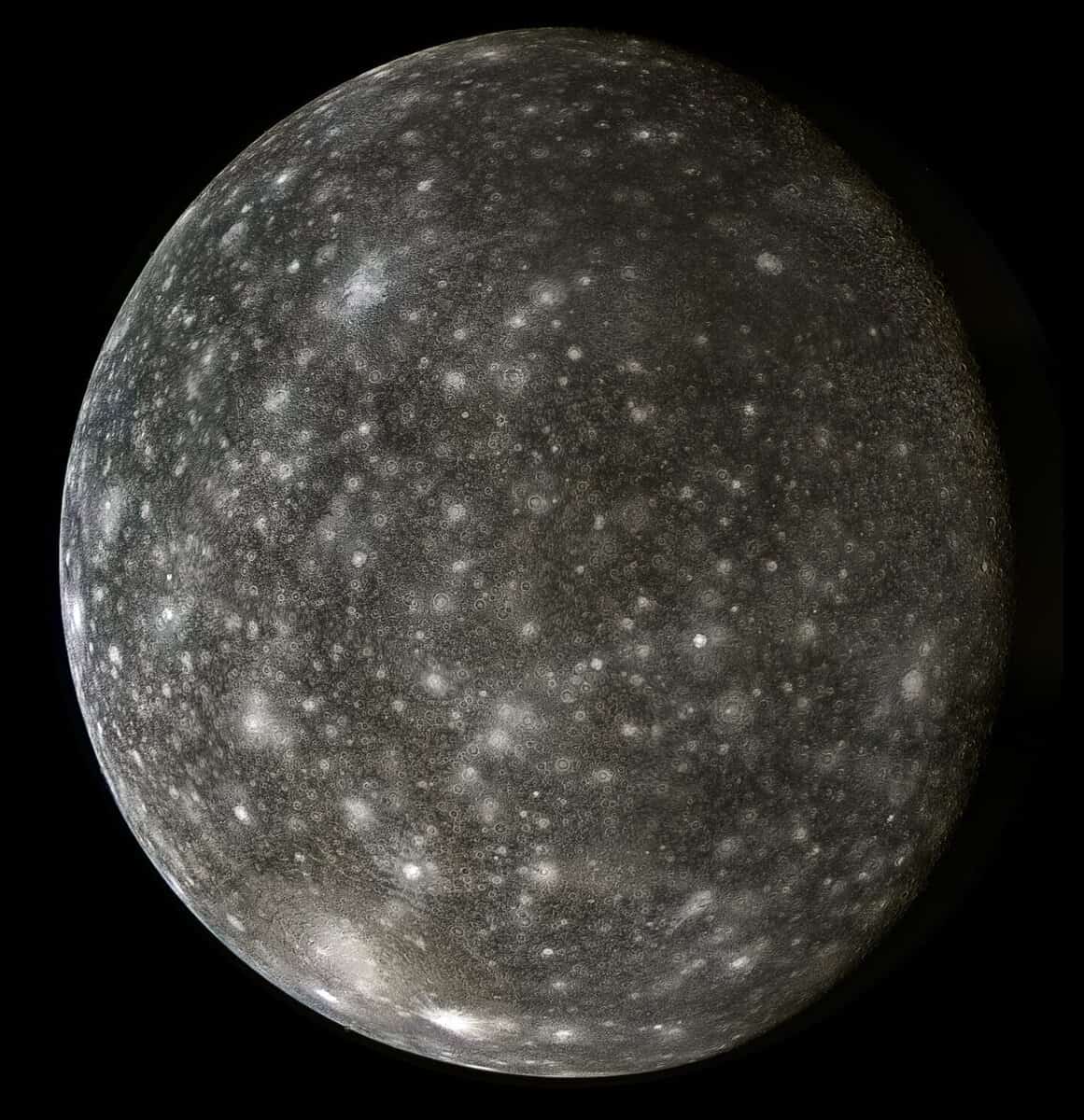
Callisto, which is one of Jupiter’s largest satellites, has a fascinating description for children. It also boasts interesting facts such as its distance from the planet, mass, temperature, rotation period, how it was discovered, and the origin of its name.
For the youngest audience, it might be intriguing to learn that Callisto is a massive moon orbiting Jupiter. It is known for its ancient crater-covered surface, which indicates that geological activity has ceased. Additionally, scientists believe that Callisto might have an underground ocean, although there is currently no evidence of life due to the moon’s old and inactive surface.
There have been multiple spacecrafts that have traveled past the satellite, including Galileo in the 1990s and 2000s. Another mission called JUICE is scheduled for the 2030s and is expected to observe Callisto as well, providing scientists with a closer look at this enigmatic moon.
Callisto’s Key Information – Kid-friendly Explanation
- Age: 4.5 billion years old (same as Jupiter). Parents or teachers can teach children that Callisto is the most pristine object in our solar system, with virtually no geological activity. It has remained unchanged since its formation.
- Io, the most distant moon of the Galileo group, is located at a distance of 1,888,000 km from Jupiter and has an orbital duration of 7 days. Children will be unsurprised by its reduced tidal influence. It is tidally locked, meaning that one side always faces the planet.
- With a diameter of 4800 km (similar to Mercury), Io is the third largest moon among the satellites, trailing behind Ganymede and Titan.
- The average temperature on Io is -139.2°C.
The discovery of Callisto – an explanation for children
Let’s begin the explanation for children by mentioning that on January 7, 1610, Galileo Galilei observed Jupiter and was amazed to find that there were multiple planets. This discovery had a profound impact on the course of human history, as it revealed that the Earth was not the center of the universe, but rather had its own place in the grand scheme. Initially, the satellite was referred to as Jupiter I, II, III, IV, but it was later given the name Callisto.
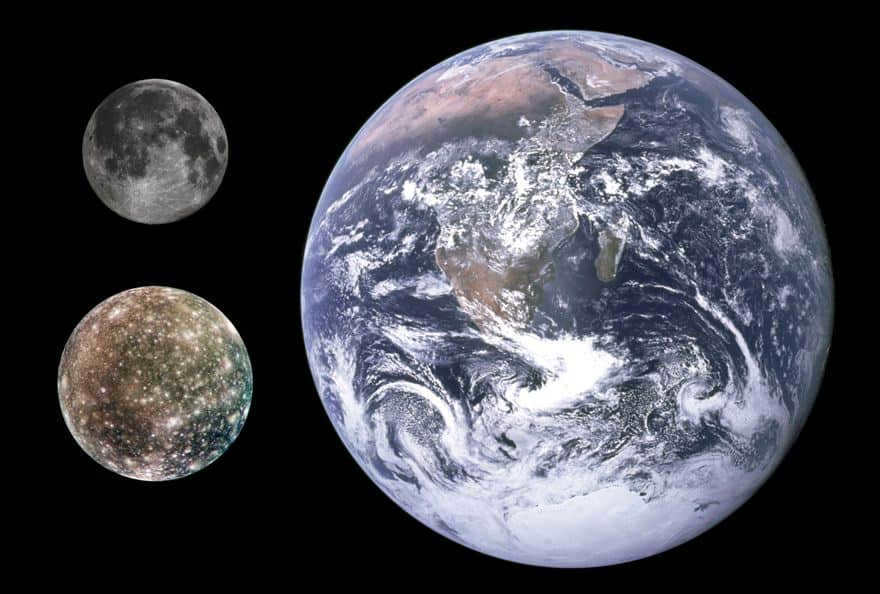
Callisto, Earth, and the Moon can be compared in terms of their sizes.
The impact of this comparison was not limited to the field of astronomy; it also had implications for religion. During that time, the Church actively propagated the belief that everything revolved around the Earth. However, this revelation shattered their arguments.
Despite significant advancements in telescopes and other space technology since the 1960s, our understanding of Callisto remains limited. Astronomers have been able to determine that its appearance is rather unremarkable, characterized by low reflectivity and density. The absence of water emission has led scientists to hypothesize that the surface of Callisto is rocky.
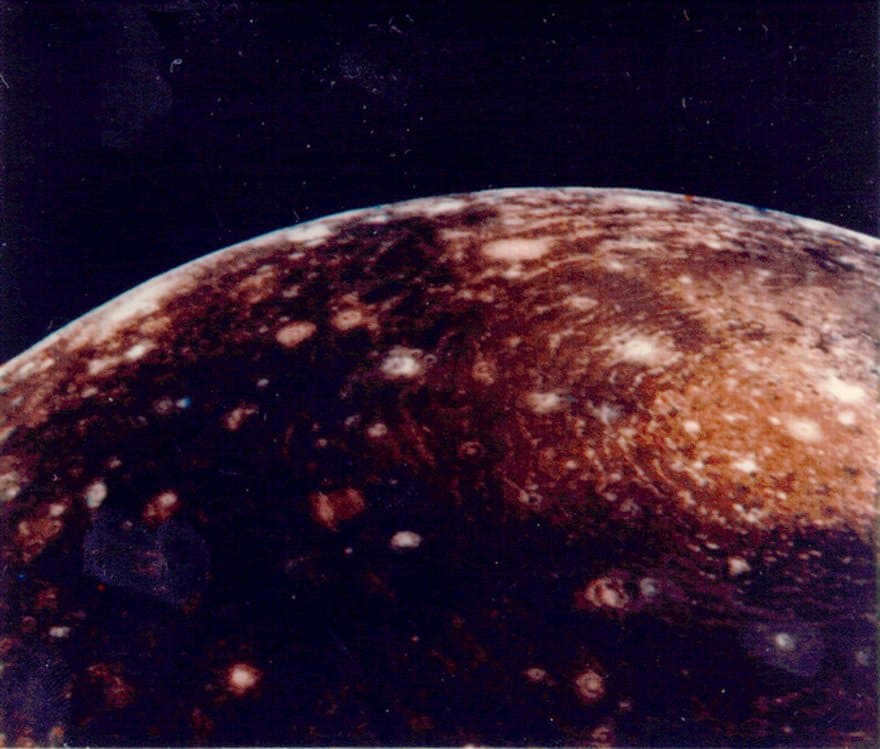

This photograph was taken by Voyager 1 and shows Callisto, one of Jupiter’s moons, from a distance of 350,000 kilometers. The large “bull’s eye” at the top is an impact basin that appeared in the early stages of Callisto’s formation. The central region is approximately 600 kilometers wide, and the outer ring measures 2,600 kilometers in width.
In the early 1970s, Pioneer 10 and 11 embarked on a mission to explore Jupiter, but unfortunately, they did not gather a substantial amount of data on Callisto. However, the Voyager spacecraft provided us with a renewed understanding of this moon, supplying valuable information about its density, temperature, and surface features at a resolution of approximately 1 km per pixel. Despite this progress, our thirst for knowledge about Callisto remains unquenched.
More information did not become available until 1996 when the Galileo spacecraft arrived, embarking on the first of a dozen missions to the moon. It was during this time that scientists discovered interesting details about the moon, including the presence of a thin carbon dioxide atmosphere and the possibility of an ocean beneath its surface. It is important for children to understand the reasons behind these assumptions. Researchers observed regular fluctuations in the moon’s magnetic field as the spacecraft orbited, suggesting the existence of electrical currents influenced by the planet’s magnetic field. Given the rocky surface and the thin atmosphere, it is plausible that there may be a salty subsurface ocean present.
As the search for answers continues regarding whether Callisto is capable of supporting life, scientists are also investigating the formation process of this enigmatic moon. The JUICE mission, primarily focused on Ganymede, aims to shed light on the mysteries of Callisto as well.


Callisto’s surface displays significant landslides within two expansive impact craters, as captured in this image taken by the Galileo spacecraft.
Recent research has developed models to study the magnetic field interactions between Jupiter and Callisto, providing substantial evidence of the presence of an ocean. Additionally, the Hubble telescope has detected atomic oxygen in Callisto’s atmosphere. Scientists also consider the number of craters and the composition of the atmosphere in their studies.
We trust that the information regarding Jupiter’s satellite Callisto has proven to be of value. When explaining this concept to children, it is advisable to provide captivating details, captivating visuals such as photos, videos, and illustrations, in order to facilitate their understanding. Furthermore, individuals of all ages will undoubtedly be enthralled by our 3D model of the Solar System, which offers a comprehensive depiction of Jupiter, including surface characteristics and prominent satellites. Although some individuals assert that Callisto can be observed in real-time through an online telescope (which seems improbable given its considerable distance from Earth and limited size for observation).
To delve deeper into the topic of Jupiter’s satellites:

Callisto, a moon of Jupiter (derived from the Latin word Callisto), ranks as one of the three largest moons in the entire solar system, with Ganymede and Titan being the only ones surpassing it in size. Unlike Earth, Callisto lacks tectonic plates, geological processes, and volcanic activity that would otherwise cause the erasure of craters on its surface. Additionally, the absence of weather phenomena prevents any significant changes in its topography over time. As a result, Callisto’s surface has remained pristine and relatively unchanged since its formation approximately 4.5 billion years ago. Scientists speculate that beneath Callisto’s icy crust lies a salty ocean, prompting plans for the construction of a research station on the moon’s surface.
Origin
Callisto, a satellite of Jupiter, originated from the gradual accumulation of material in the gas-dust disk that surrounded the planet after its formation. The slow rate of mass accumulation and weak tidal heating resulted in insufficient temperatures in Callisto’s interior for differentiation.
As the formation of Callisto progressed, slow convection started inside the satellite, leading to partial differentiation. This process gave rise to the formation of a surface ocean at a depth of 100-150 km and a small silicate core.
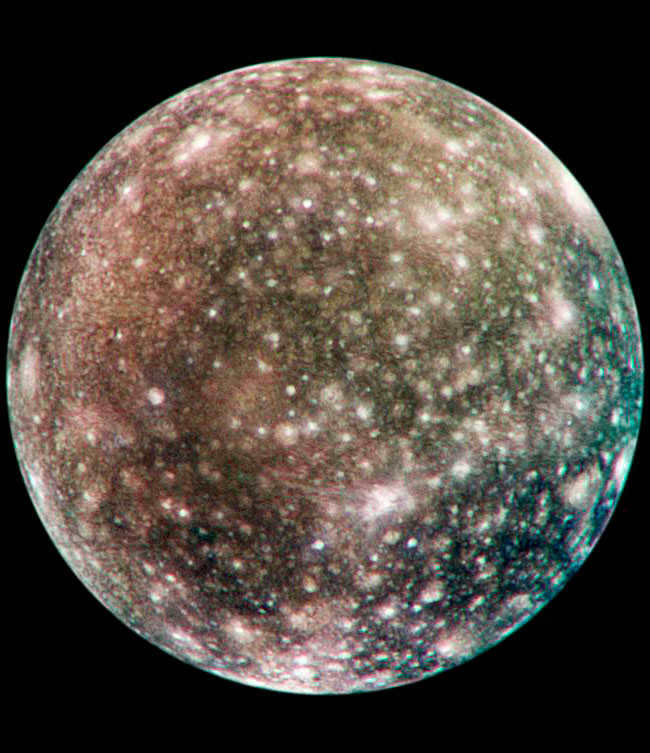
The discovery of the satellite Callisto occurred in 1610 when Galileo Galilei, along with three other significant satellites of Jupiter – Europa, Io, and Ganymede, observed it. Initially, Callisto was known as Jupiter IV, as per Galileo’s naming convention. This designation was commonly used in early astronomical literature.
However, later on, Johannes Kepler introduced new names for the Galilean satellites to make them more identifiable. Consequently, Jupiter IV was renamed Callisto, which was the name of one of the lovers of the ancient Greek god Zeus. According to mythology, Zeus transformed Callisto into the constellation of the Big Dipper to protect her from his wife Hera’s anger.
Although Kepler’s proposed name was not immediately embraced by the scientific community, it gradually gained acceptance and became widely used in the middle of the twentieth century.
Physical attributes


Callisto is recognized as the second largest moon of Jupiter, following Ganymede, and the third largest moon in the entire solar system. With a diameter of 4821 kilometers, Callisto’s size is equivalent to 38% of Earth’s diameter. This moon’s mass exceeds an astounding 10 quintillion tons. Although Callisto shares a similar size to Mercury, its weight only constitutes 30% of the planet’s mass due to its low density of 1.86 g/cm³.
Physical attributes of Callisto:
| Indicators | Values of indicators |
| Equatorial radius | 2403 km |
| Mass | 10.8×1022 kg |
| Average density | 1.86 g/cm³ |
| Acceleration due to gravity at the surface | 1.25 m/s2 |
| Second escape velocity | 2.45 km/s |
| Albedo | 0,19 |
| Surface temperature | -120-140 °С |
Callisto is located approximately 1.9 million km away from the central planet, while its closest neighbor Ganymede is more than 800,000 km away.
Atmosphere
Callisto possesses a delicate and thin atmosphere composed of carbon dioxide, which stretches around 100 km above the surface of the moon. This atmosphere is fleeting in nature, lasting no longer than 4 days before dissipating into space, thus necessitating a continuous supply.
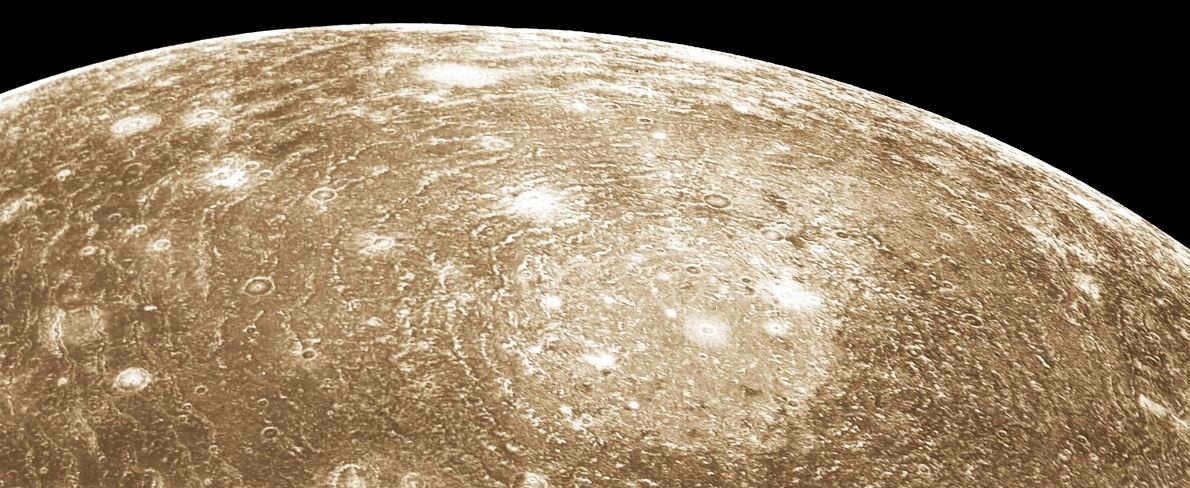
The main component of the atmosphere on Callisto is carbon dioxide. It is believed by scientists that the carbon dioxide molecules near the surface have a partial pressure of 7.5×10-12 bar at a temperature of -123.15 °C. However, it is possible that the actual pressure is 20-100 times higher. While molecular oxygen has not been detected as part of the atmosphere, the presence of a high electron density in the ionosphere suggests that there may be significant quantities of oxygen here.
The temperature on Callisto’s surface rises to -123.15 °C at sunrise, but quickly drops as the Sun sets.
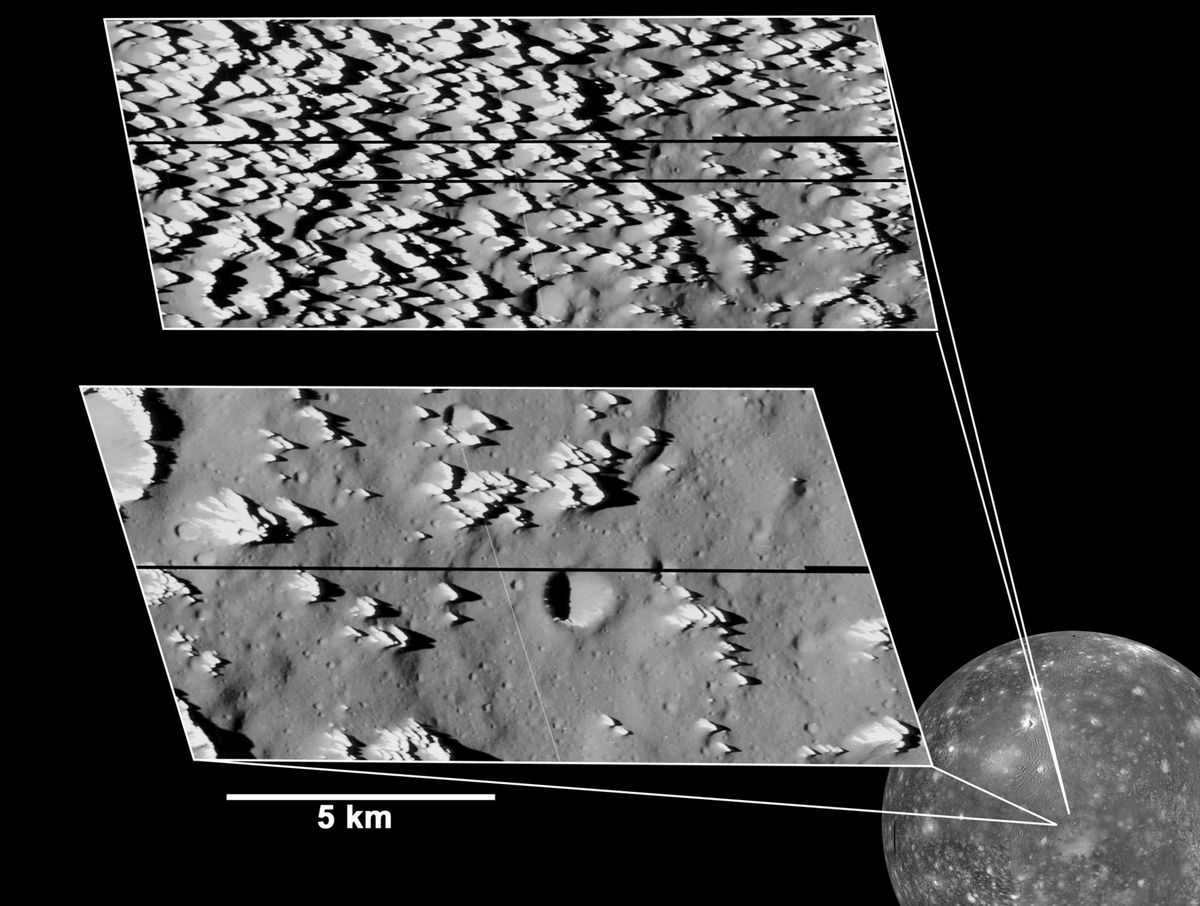

Surface
Callisto’s surface is covered with a dense layer of impact craters. In terms of the number of craters, this moon holds the record in the entire Jupiterian system.
It might even be the most cratered celestial body in the entire solar system. However, there are no other natural formations present, such as mountains, volcanoes, or faults, indicating a lack of tectonic activity on this moon.
The craters on Callisto vary in size, ranging from 100 m to 100 km, and they also exhibit different shapes.
Sizes and shapes of craters on Callisto:
| Size of Crater | Shape of Crater |
| Up to 5 km | Flat |
| Between 5 and 30 km | With a peak in the center |
| Between 30 and 100 km | With a pit in the center |
| 60 km | With a dome |
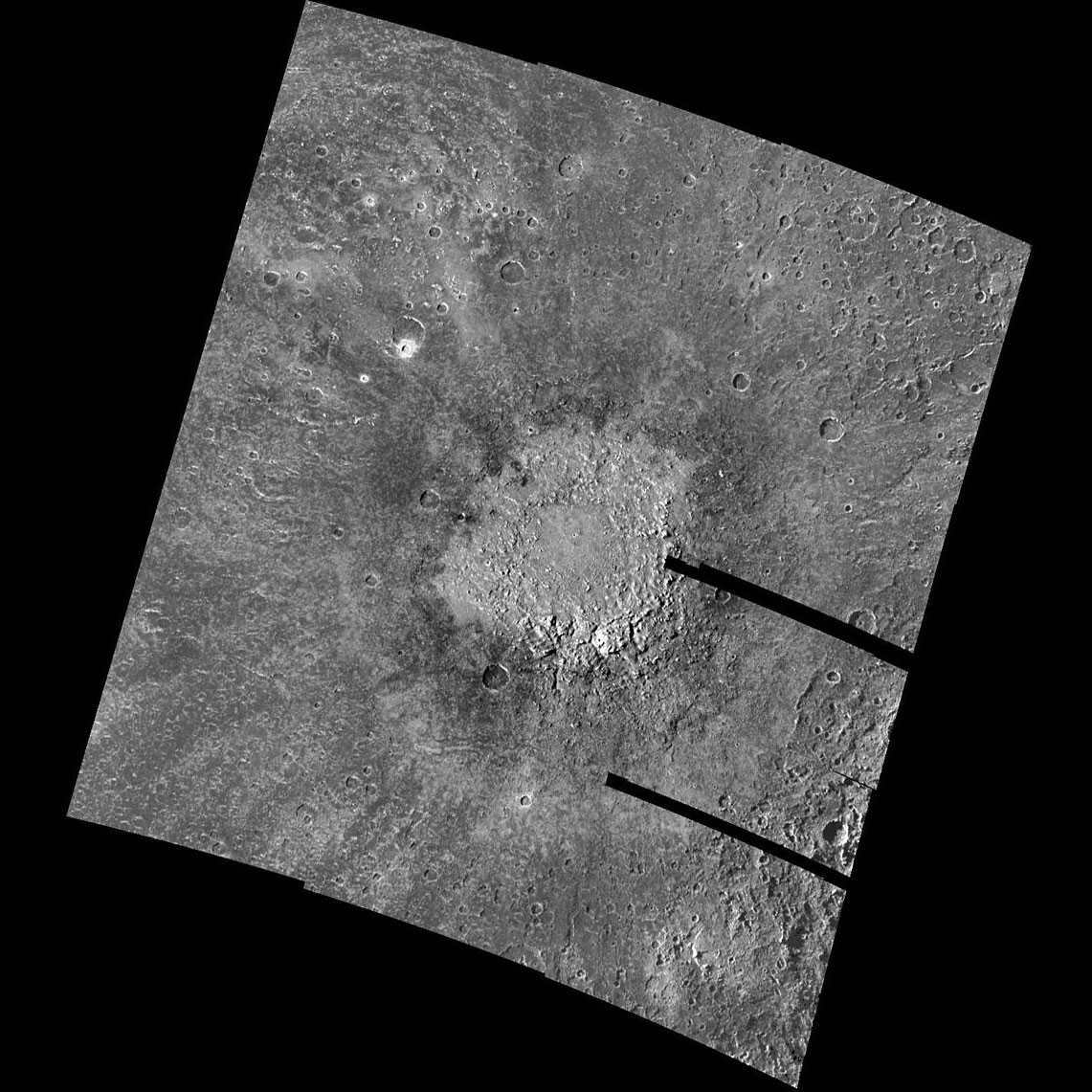
The prominent feature in the middle is the Loughn crater, while Adlinda can be faintly seen in the top left corner.
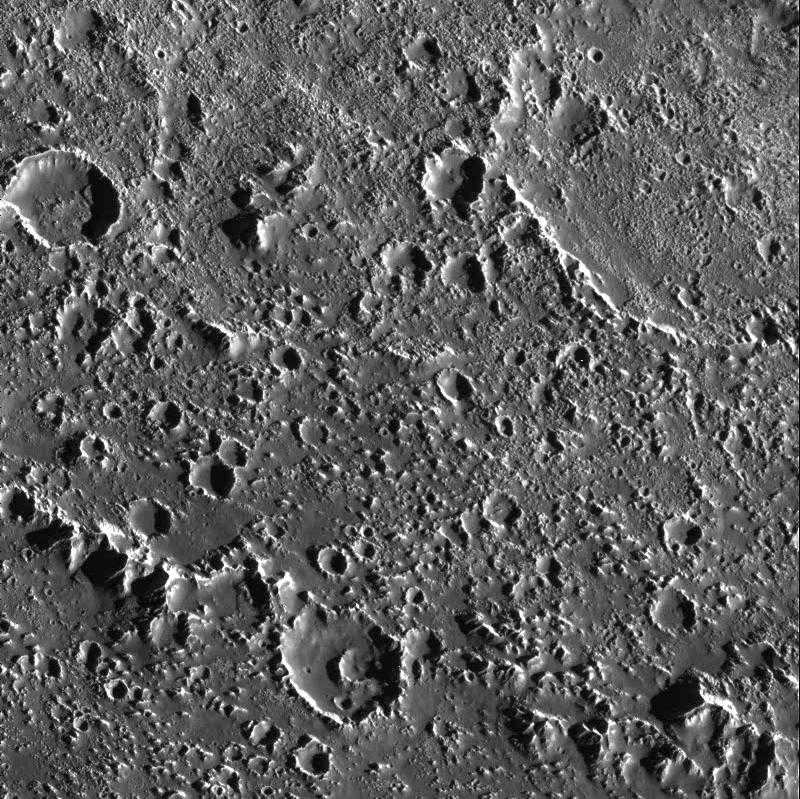
The largest impact features on Callisto include the Asgard (diameter 1600 km), Adlinda (diameter 1000 km), and Valhalla (diameter 600 km) crater basins. These formations emerged on the surface of the moon as a result of multiple collisions during periods of intense asteroid bombardment from outer space. Following these asteroid impacts, a series of concentric rings, measuring up to 1600 km in diameter, formed on the moon’s surface.
Although Callisto’s surface primarily consists of ice, its albedo is only 19%. This is likely due to contamination from silicate dust and other impurities. However, recent deep craters reveal pristine white ice beneath the surface and appear highly reflective.
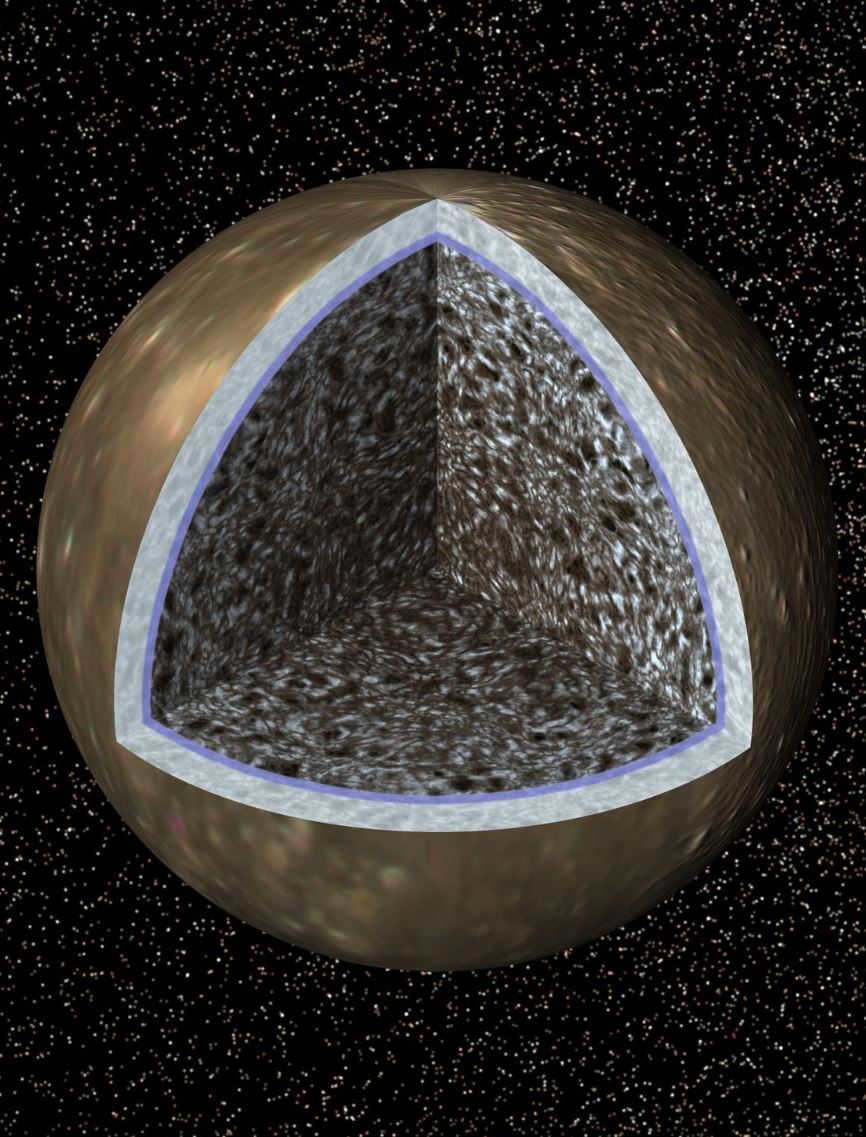
Scientists were surprised by a recent discovery: a liquid salty ocean exists beneath the icy surface of Callisto. This finding is unexpected, as researchers had previously believed that the satellite was relatively inactive.
If there is indeed an ocean hidden within Callisto, then this celestial body would be more similar to another of Jupiter’s moons, Europa, which also has an ocean beneath its icy surface.
The layer sequence on Callisto is as follows:
- An ice layer that is 200 kilometers deep;
- An ocean that ranges from 19 to 100 kilometers deep;
- Homogeneous structures of compacted ice and rock.
Callisto does not have a core. Its deep structures consist of 60% rock, including iron and its sulfites, and 40% compressed ice. As the depth increases, the proportions of ice and silicates will shift in favor of the latter.
Due to the significant amount of ice present in Jupiter’s composition, its density is exceptionally low, measuring only 1.86 g/cm3.
Magnetic Field
A magnetometer installed on Galileo’s surface detected the fluctuating magnetic field of Callisto.
This phenomenon could originate from alternating electric currents coursing through Callisto’s surface, corresponding to changes in the magnetic field caused by Jupiter’s rotation.
Callisto’s thin atmosphere lacks charged particles and is incapable of generating a magnetic field. While an ice crust is a poor conductor, it is possible that it conceals a layer of melted ice.
If this liquid ocean contains salt, similar to Earth’s, it could generate sufficiently strong electric currents to produce a magnetic field.
Additional research into the probability of a briny sea beneath the surface of Callisto uncovered the presence of electric currents flowing in various directions and at different intervals. This observation aligns with the concept of an ocean rich in salts, especially considering that Callisto is in synchronous orbit with Jupiter, much like Europa.
Orbit and rotation
Callisto has the farthest distance from Jupiter compared to the other Galilean satellites. Its movement is influenced by the planet’s gravity, interactions with the other Galilean satellites, and its resonance with Ganymede.


An analysis of the trajectory of Callisto:
Callisto completes one full orbit around Jupiter every 16.7 days, while Ganymede completes its orbit in just 7 days. The other Galilean satellites have a more complex relationship, with their orbital periods forming a 3:7 resonance.
Callisto is in a gravitational lock with Jupiter, meaning that their rotation periods are synchronized. This causes Callisto to always have the same side facing Jupiter.
Investigation
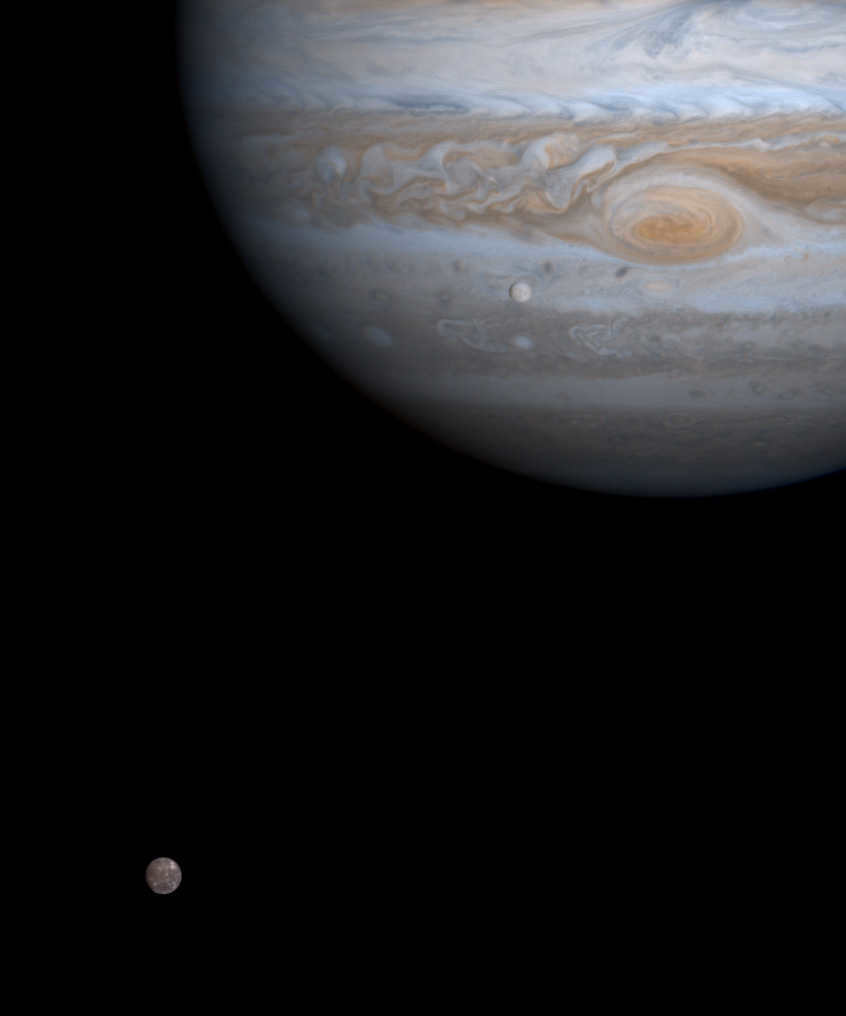
The primary information about Callisto was acquired thanks to the Galileo spacecraft. While on its way to other celestial bodies, the AMS Pioneer 10, Pioneer 11, Voyager 1, Voyager 2, Cassini, and New Horizons also conducted studies on this moon of Jupiter.
In 1970, the Pioneer-10 and Pioneer-11 research stations made close flybys of Jupiter, but their findings only marginally contributed to our understanding of Callisto’s surface and internal structure.
The real breakthrough in our knowledge of this moon came in 1979-1980 when the Voyager 1 and Voyager 2 spacecraft flew near Jupiter and captured images of half of Callisto’s surface with a resolution of 1-2 km.
The exploration of Callisto entered a new phase in 1994 with the launch of the Galileo spacecraft. Over the course of its mission, the spacecraft made eight flybys of Callisto, with the final one bringing it within 138 km of the satellite’s surface and capturing images with a resolution of 15 meters. The Galileo mission spanned nine years and concluded in 2003.
In 2000, the baton of studying Callisto was passed to the Cassini spacecraft during its mission to Saturn. Cassini obtained high-resolution infrared photographs of Callisto, adding to our understanding of the moon. Then, in February-March 2007, the New Horizons spacecraft, on its way to Pluto, contributed new photographs and spectra of Callisto to further our knowledge.
The Juice mission has plans to venture to Jupiter within the next ten years, with its primary objective being the exploration of Europa and Ganymede. As part of this mission, the spacecraft intends to conduct a close approach of Callisto to capture new and detailed images of the satellite’s surface. Furthermore, preparations are underway for the EJSM mission, which involves the collaboration of NASA and ESA to launch up to four vehicles for an interplanetary expedition.
Callisto Colonization
Callisto, with its stable geology and minimal exposure to Jupiter’s radiation belts, has captured the attention of Earth’s scientific community as a potential site for a research station to facilitate further exploration of the cosmos by humanity. The abundance of ice on Callisto is of particular significance, as it can be harvested and utilized to meet our pressing economic demands. Moreover, from the surface of Callisto, we are afforded the unique opportunity to observe another of Jupiter’s moons, Europa.
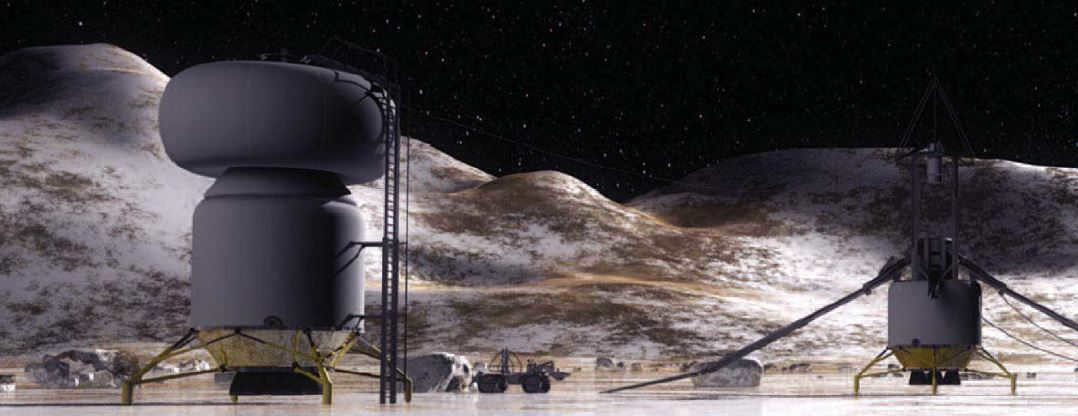

A potential manned mission to Callisto is being considered for the 2040s. The estimated duration of the mission is projected to range from 2 to 5 years. In order to establish a research outpost, scientists are planning to send multiple spacecraft to the moon, with one carrying the crew and the others transporting necessary building materials.
The likelihood of existence
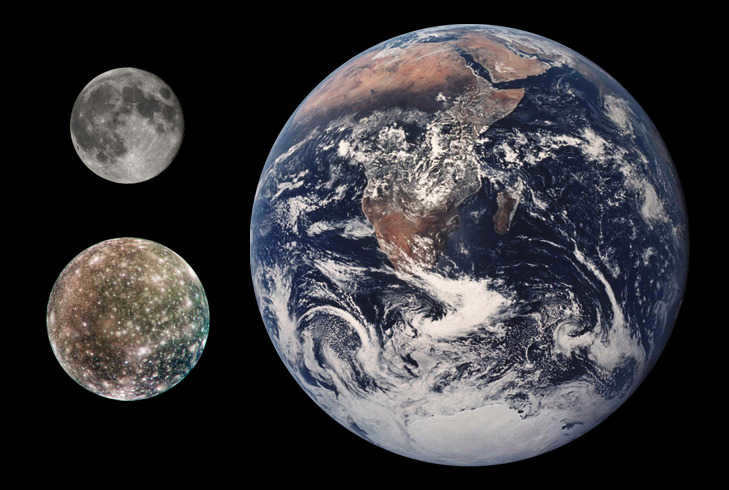
If there exists an ocean beneath the surface of Callisto, it implies the potential for life, particularly if the water is saline.
The primary hindrances to the emergence and evolution of any organisms are the inadequate heat flow from the satellite’s interior and limited interaction with rocks.
The circumstances for the genesis and sustenance of life on Callisto are comparatively less favorable than those on Europa and Ganymede.
Video presentation on scientific facts
Callisto, one of Jupiter’s four Galilean satellites, is the second largest moon after Ganymede in both the Jupiter system and the entire solar system. With a size comparable to that of Mercury, Callisto is a significant celestial body.
Even with binoculars, all four of Jupiter’s Galilean satellites – Io, Europa, Ganymede, and Callisto – can be easily observed. Callisto, being the farthest from the planet, experiences a weaker influence from Jupiter, resulting in a lower level of radiation on its surface compared to the other moons. This characteristic makes Callisto an attractive candidate for future exploration and potentially establishing a base near the largest planet in our solar system.
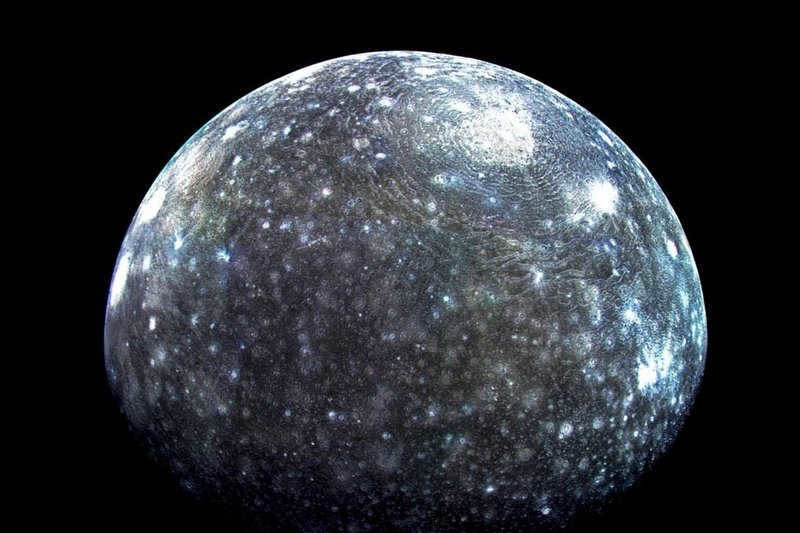
Overview of Callisto
Callisto, one of Jupiter’s moons, follows a slightly elliptical orbit with an eccentricity of 0.0074. When closest to Jupiter (perigee), the distance between the two celestial bodies is 1,869,000 km, while at its farthest point (apogee), the distance extends to 1,897,000 km. It takes Callisto approximately 16.7 days to complete a full orbit around Jupiter. Due to tidal capture, the moon is tidally locked, always keeping one side facing Jupiter. The gravitational influence of the other Galilean moons on Callisto is relatively weak.
With a diameter of 4,820 km, Callisto measures approximately 38% the size of Earth or 99% the size of Mercury. Interestingly, Callisto is significantly larger than our Moon, which has a diameter of just 1,346 km.
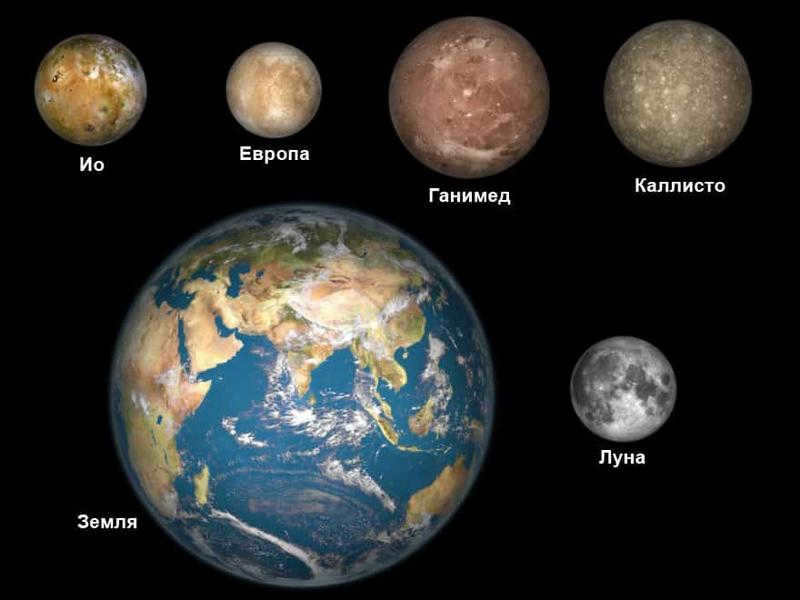

The sizes of Jupiter’s satellites, Earth, and the Moon can be compared.
Callisto, which is almost the same size as Mercury, has a density of 1.83 g/cm3, making it three times lighter. Unlike Mercury, which has rocky rocks and a massive metallic core, Callisto has an equal amount of ice and rock.
Callisto experiences a free fall acceleration of 1.235 m/s2, which is only 12% of Earth’s.
The inner composition of Callisto
Callisto, the moon, is thought to have originated from the leftover materials of a gas-dust disk that existed after the creation of Jupiter. Because of the weak gravitational pull from the planet at its distance, there were no significant tidal forces that could generate heat within the moon. Nevertheless, there was some separation of materials, with silicate rocks sinking downwards and creating a small rocky nucleus at its core.
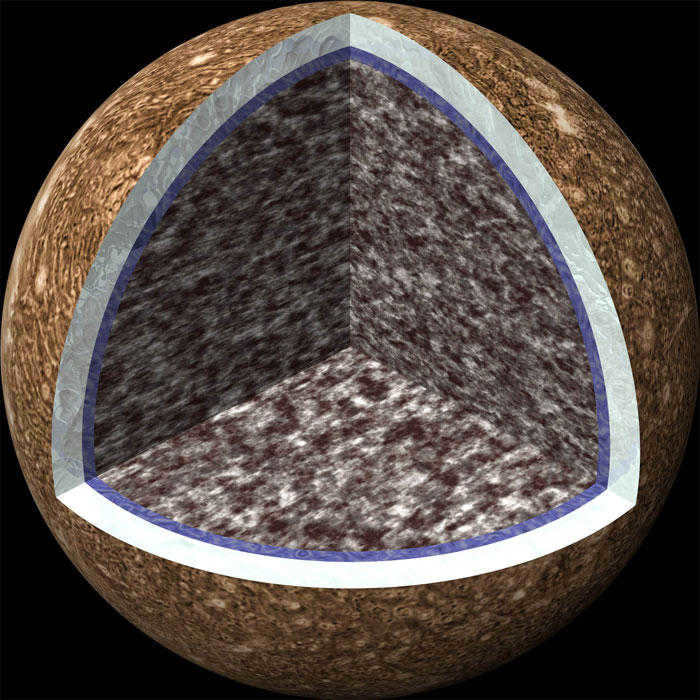

The internal composition of Callisto.
Callisto’s uppermost layer, known as the lithosphere, is a thick icy crust measuring between 80 to 150 kilometers, and potentially even twice as thick. Within this layer, researchers have discovered significant quantities of carbon dioxide, predominantly in the form of ice. However, the primary components consist of a combination of water ice and silicates.
By examining the impact of Jupiter’s magnetic field on this moon, scientists have concluded that it does not penetrate deep into the interior due to the presence of a solid layer of electrically conductive liquid, which acts as a barrier.
It is highly probable that Callisto, beneath its lithosphere, harbors a subglacial ocean with a minimum depth of 10 kilometers. However, if this water contains ammonia or other substances that prevent freezing, the ocean’s depth could reach up to 300 km.
The likelihood of a saltwater subglacial ocean on Callisto increases the possibility of primitive life existing there. Despite having harsher conditions compared to its satellite counterpart, Europa, Callisto remains an intriguing destination for scientific exploration.
Beneath the subglacial ocean lies a mantle composed of a mixture of rock and ice. As one delves deeper towards the core, the concentration of silicates, which have settled over time, increases. The interior of this satellite has not yet fully stratified or differentiated, resulting in a chaotic blend of ice and rock, with only their proportion changing with depth.
The silicate core at the center of Callisto measures no more than 600 km in diameter.
Exploring Callisto
Callisto is one of the satellites in the Galilean group, which also includes Ganymede, Europa, and Io. These satellites were named after Galileo Galilei, who discovered them in January 1610. However, studying them was challenging before the era of spaceflight due to their small size and remote location. As a result, limited information was available about them for a long time.
The first spacecraft to approach Jupiter was the American probe Pioneer 10, which flew past the planet in December 1973. Exactly one year later, Pioneer-11 also flew by the planet. However, these missions primarily focused on studying Jupiter itself and measuring its parameters, providing only limited information about its satellites.
The Galileo probe, launched specifically to study Jupiter and its system, provided even more extensive information. From 1994 to 2003, it approached Callisto a total of 8 times, reaching heights as low as 138 km and capturing numerous highly detailed surface images, some with a resolution as fine as 15 meters.
In 2000, the Cassini probe, originally sent to explore the Saturn system, flew past Jupiter and captured infrared images of Callisto. Additionally, in 2007, the New Horizons probe, en route to Pluto, gathered further data on Callisto.
The data obtained from these interplanetary probes has greatly enhanced our understanding of Callisto, providing a wealth of valuable information about this moon.
The Surface of Callisto
Callisto, one of Jupiter’s moons, boasts a surface that is adorned with craters of various sizes. In fact, this moon is believed to have the highest concentration of craters in the entire solar system. These ancient craters are constantly being overlaid by newer ones, gradually erasing their existence.
What makes Callisto’s surface particularly intriguing is its varied coloration. Light and dark areas intermingle, creating a seamless blend. Scientists hypothesize that the light areas are the result of ice ejecta after meteorite impacts, while the dark areas consist of rock, dust, and other mineral elements.
Among the notable formations on Callisto’s surface is Valhalla, a massive circular basin measuring 1,800 kilometers in diameter. At its center lies a luminous core spanning 600 kilometers, surrounded by concentric rings that radiate outward.
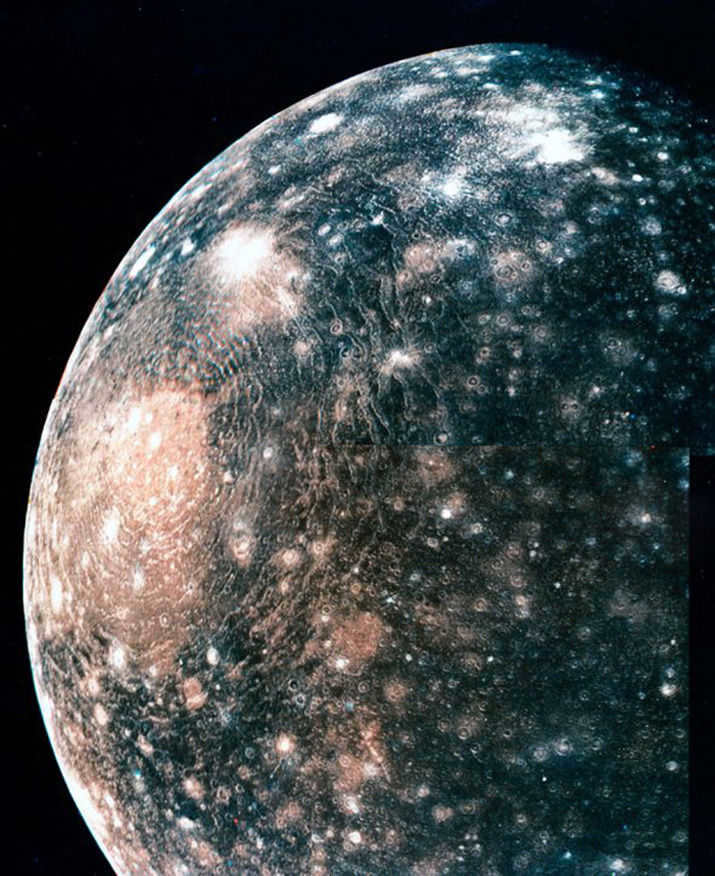
The ring structure on Callisto known as Valhalla crater and its associated ring structure can be seen in this image.
Asgard, another similar structure on Callisto, is slightly smaller with ring diameters reaching 1600 km.
It is believed that each of these ring basins formed as a result of a large impact. The wave-like fractures in the lithosphere, which sits on a liquid base, are responsible for the formation of these ring structures. It is hypothesized that beneath the lithosphere lies a subglacial ocean. The hydraulic action caused by the impact could have led to the creation of these ring structures.
The unique characteristic of Callisto’s surface is that, despite the abundance of craters, it appears quite smooth due to erosion. This is primarily due to the gradual sublimation and evaporation of ice on the sunlit side. With a significant amount of ice present, the craters and other irregularities slowly erode over time. As a result, collapses and landslides occur.
One theory suggests that this active erosion has led to the absence of small craters measuring less than 1 km in diameter on Callisto’s surface. Instead, there are numerous hills and depressions, likely remnants of these smoothed-out craters. The shafts transform into hills, while the craters become depressions, and the transitions between them gradually level out.
As a result of ice sublimation, the presence of ice on the surface of Callisto has gradually diminished, resulting in the formation of numerous dark regions composed solely of mineral rock devoid of any volatile components. The rock was once part of the impure ice before the ice evaporated. These extensive rock formations act as a barrier, inhibiting further evaporation of the underlying ice.
Atmosphere of Callisto
The Galileo probe provides all the information about the atmosphere of Callisto.
Callisto possesses an atmosphere, albeit a very thin one composed mostly of carbon dioxide. Typically, a satellite would lose such an atmosphere within just 4 days, but Callisto’s atmosphere endures for a significant period of time. This suggests a continuous replenishment process. It further supports the theory of ice sublimation on Callisto’s surface, as the upper layers are enriched with carbon dioxide. As the dry ice evaporates, it contributes to the atmosphere’s carbon dioxide content.
The issue of Callisto’s atmosphere is still in need of further study and clarification. Future missions may provide more details on this topic.
Potential for Establishing a Colony on Callisto
Jupiter’s Galilean moons are large and possess sufficient gravity, making them ideal candidates for future research bases. However, only one of these moons, Callisto, is suitable for this purpose. The reason for this is that the radiation levels on the other moons are too intense, posing a deadly threat to human life. On the other hand, Callisto is located farthest from Jupiter, and even its surface radiation levels are relatively safe.
In addition to its distance from Jupiter, Callisto offers another advantage in the form of geological stability. Unlike the other moons, Callisto experiences no unexpected or dangerous events such as volcanic eruptions or surface cracks.
NASA evaluated the potential of Callisto as a potential site for a base in 2003. The moon could be utilized for the extraction of fuel from its ice deposits, as well as for refueling and servicing spacecrafts heading further into space. Additionally, Callisto offers a convenient and safe vantage point for the study of Jupiter and its other moons, particularly Europa, which is believed to harbor a promising subglacial ocean. The possibility of a manned mission to Callisto has been projected to be achievable by the 2040s.
Callisto holds the distinction of being the third largest natural satellite in the entire solar system. Among Jupiter’s Galilean moons, it is the second largest in size.
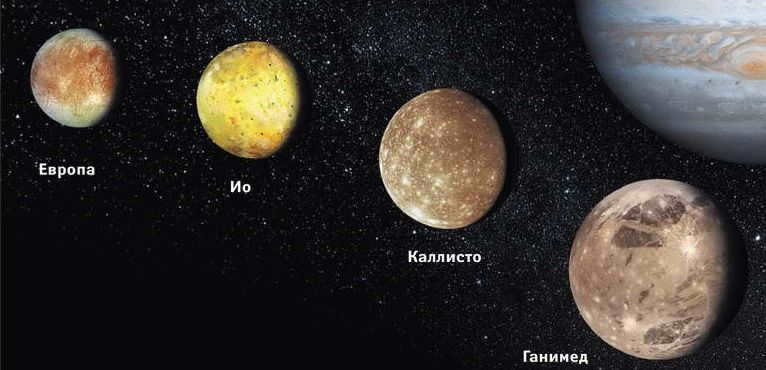

The discovery and naming of Jupiter’s moon, Callisto
Callisto, one of Jupiter’s satellites, was first observed by Galileo in January 1610, along with three other moons. Interestingly, the name “Callisto” was not given by Galileo himself, but by the German astronomer Simon Marius. Marius claimed to have independently discovered the moons a few days before Galileo. In Greek mythology, Callisto was a nymph in the retinue of Artemis, the goddess of the hunt. She was also the beloved of Zeus, who transformed her into the constellation Ursa Major, or the Big Dipper, and placed her in the night sky.
Primary characteristics
This celestial object is estimated to be approximately 4.5 billion years old, making it around 40 million years younger than both Earth and Jupiter. It is the most recent of the four “Galileo satellites” and is not believed to have ever been in orbital resonance with the other three.
Dimensions, mass, and trajectory
Callisto has a radius of 2410 km, which is roughly 38% of Earth’s radius. It weighs over 100 quintillion tons (using the short scale system, which is commonly used worldwide, this amount is represented by 18 zeroes). The size of this celestial body is comparable to that of the planet Mercury, but its mass is significantly lower than that of Mercury.
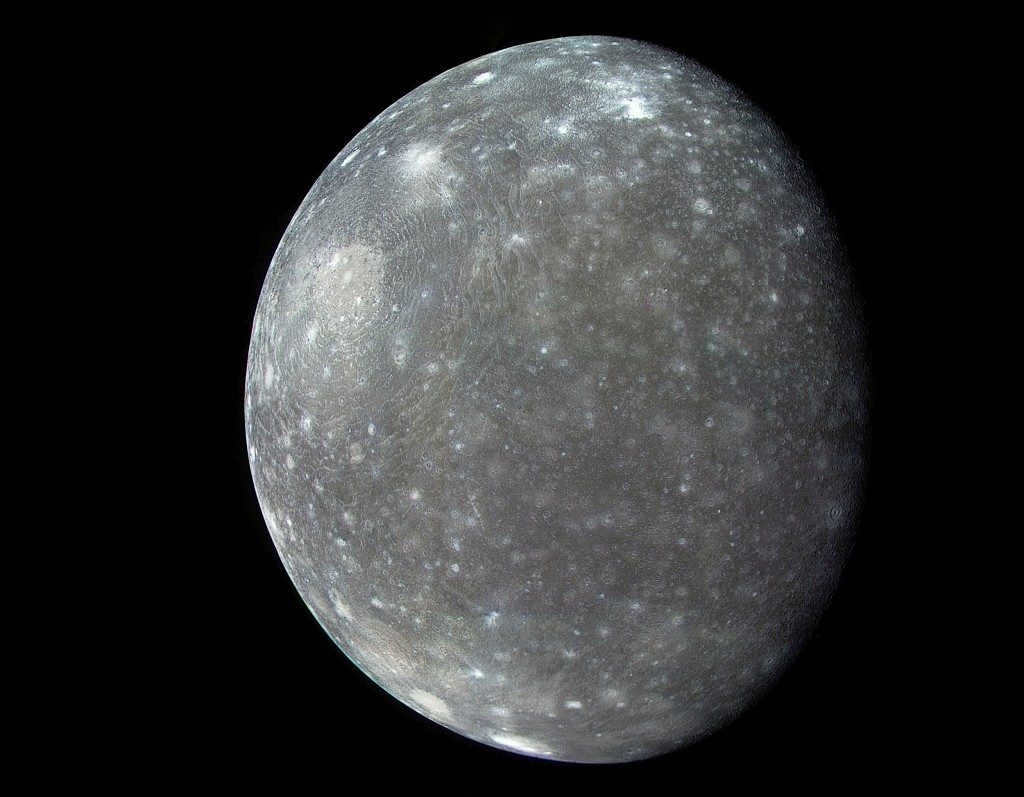
The average distance between the satellite and its central planet is approximately 1.9 million kilometers, while the distance to its closest neighbor (Ganymede, which is also part of the Gallilean group) is over 800 thousand kilometers. The satellite and Jupiter are gravitationally locked, meaning that Callisto’s orbital period and rotation time around its axis are the same, lasting 16.5 Earth days.
Callisto’s Composition and Surface
Callisto’s body has a density of 1.83 g/cm³, indicating an equal distribution of water ice and a rocky component composed of chondrites, silicates, and iron oxide. Additionally, the upper crust contains:
- ammonia;
- hydrated silicates;
- sulfur dioxide;
- carbon dioxide;
- magnesium;
- various organic compounds.
Beneath the surface of rock and ice lies an icy lithosphere that extends to a depth of 80-150 meters. Below this, there may be a saltwater ocean reaching a depth of 50-300 km. The presence of this ocean is suggested by certain characteristics of Jupiter’s magnetosphere. Deeper still, the interior of Callisto is expected to consist of a combination of ice and rocks, with the proportion of rocks increasing as depth increases.
Craters on Callisto
Callisto’s surface is extensively marked with craters. Among all the celestial bodies in the Jupiter system, Callisto boasts the highest number of craters. It is possible that it is even the most heavily cratered object in proximity to the Sun, although it lacks any other geological features such as mountains, tectonic faults, or volcanoes.
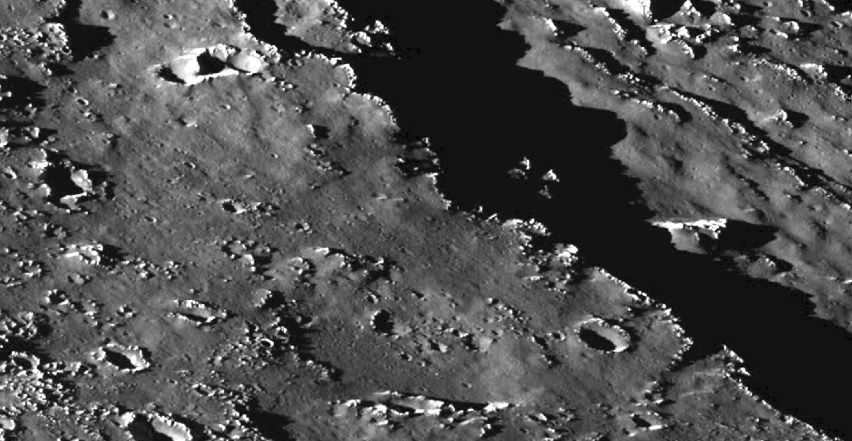
The dimensions of the craters on Callisto range from 100 meters to 100 kilometers. Small craters, with a diameter of up to 5 kilometers, are mostly flat, while formations with a diameter of 5 to 30 kilometers have central peaks. The largest craters, with diameters of 30 to 100 kilometers, have central pits instead of peaks. Additionally, many craters with a diameter of about 60 kilometers have formed domes.
A unique feature on Callisto is the presence of multicircular crater basins. These basins are likely the result of concentrated ruptures caused by multiple impacts during intense asteroid bombardments. The three largest known basins on Callisto have diameters of 600 kilometers (Valhalla), 1000 kilometers (Adlinda), and 1600 kilometers (Asgard).
Fascinating trivia: Valhalla is ranked as the 13th largest crater in the Solar System, considering solely its central region. Nevertheless, it showcases concentric rings that bear a striking resemblance to ripples on water caused by a thrown stone.
The outermost ring boasts a diameter of nearly 2000 km (some sources claim 4000 km), thereby earning the title of the most expansive crater basin in the examined portion of the Universe.
Map of the Surface
The celestial object appears dark with an albedo of just 0.2, however, the satellite’s surface is uneven, with distinct bright patches that can be observed. These bright spots are areas of pure ice, which have a reflectivity of up to 0.8. The topography of Callisto has remained unchanged for a considerable period of time and has not been altered due to the complete absence of any geological activity in this region.
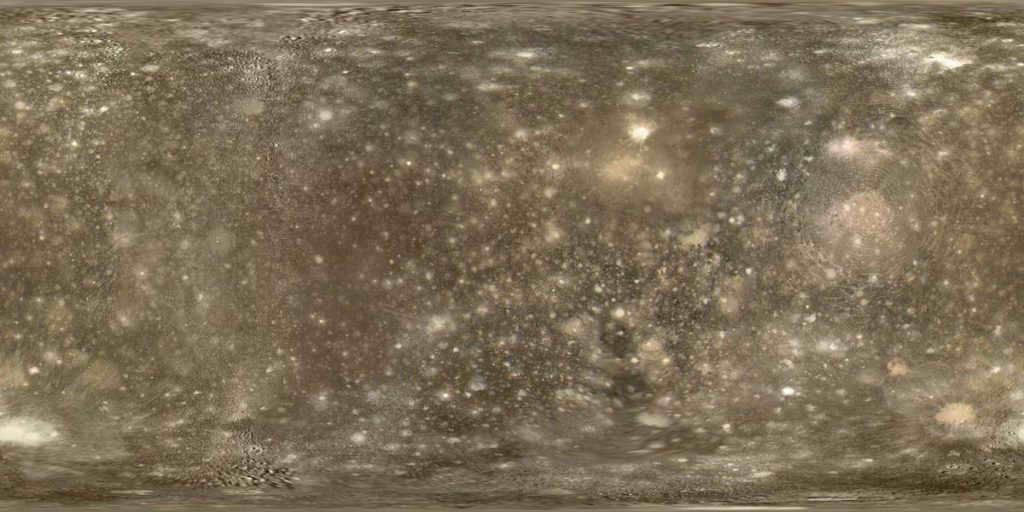
Jupiter’s moon’s air
This satellite possesses a feeble and thin atmosphere that consists mostly of carbon dioxide. The distinctive feature of this air layer is its volatility; it evaporates and disappears within 4 days, necessitating a constant refill.
No molecular oxygen has been detected on the moon; however, the high concentration of electrons in the local ionosphere suggests that it might be present in substantial quantities.
The atmosphere’s altitude reaches approximately 100 km.
Pioneer 10 and 11 were the first spacecraft to approach Callisto, one of Jupiter’s moons, in 1973-1974. However, they did not reveal any new information about the moon, only confirming what had already been observed through Earth-based telescopes. The Voyager program’s space probes, on the other hand, explored over half of Callisto’s surface, determined its mass, clarified its shape, and measured its temperature parameters.
The Galileo probe made 8 flybys of Callisto, capturing numerous close-up images and providing the majority of the data about the moon. In 2000, the Cassini spacecraft, en route to Saturn, conducted some studies of Callisto in the infrared spectrum. The next set of images was obtained in 2007 and transmitted to Earth by the New Horizons spacecraft, which was on its way to the outer reaches of the solar system.
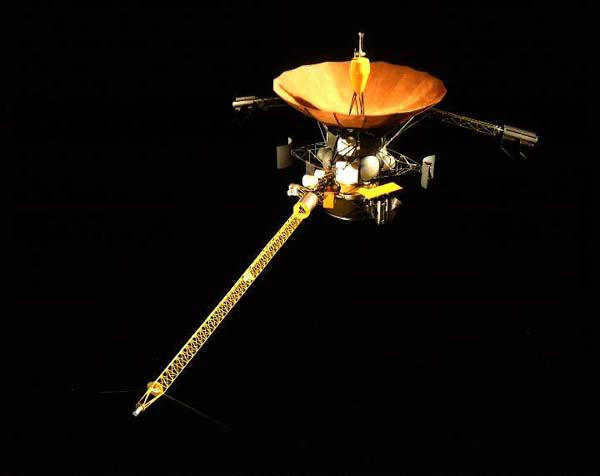
In 2022, a mission called “Juice” is scheduled to be launched with the objective of studying Ganymede and Europa. Additionally, the spacecraft will also approach Callisto.
During the same period, the “EJSM” mission ships, jointly prepared by the American and European space agencies NASA and ESA, will also be sent to Jupiter. This program aims to send up to 4 vehicles on an interplanetary journey.
Satellite Habitability: Exploring the Possibility of Life Beyond Earth
When contemplating the potential for life beyond Earth, scientists often turn their attention to satellites with oceans hidden beneath their rocky exteriors. The presence of an ocean on a satellite opens up the tantalizing possibility of habitability, particularly if the water is saline. However, several challenges must be overcome for life to emerge and thrive in these extraterrestrial environments, including low heat flow from the satellite’s interior and limited contact with rocks. While the conditions for life may not be as favorable as those found on Ganymede or Europa, the potential for habitability on these satellites remains an intriguing area of study.
Potential Colonization of Callisto
Callisto, a moon of Jupiter, offers enticing opportunities for potential colonization by humans. This celestial body boasts abundant water resources in the form of its icy surface and the possibility of a liquid ocean. Additionally, Callisto provides a stable geological environment and is situated at a considerable distance from its central planet. As a result, the detrimental effects of Jupiter’s radiation field are significantly diminished, being approximately 300 times less intense compared to its neighboring moon, Europa.

